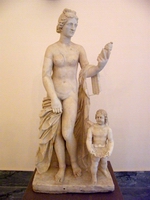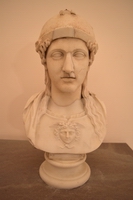Indice dei Musei
presenti in miti3000
Napoli Museo Nazionale - Piano Terra - Collezione Farnese - sala XXVI
Testo
Sala XXVI - La Farnesina
La Roma del Cinquecento è tutto un crescere di “horti”, “vigne” e “giardini all’antica”, nei quali vengono ordinatamente esposte sculture ed epigrafi al fine di suscitare l’honesta voluptas (il decoroso piacere) dei visitatori ed esaltare la magnificenza dei fortunati possessori.
Alla memoria degli antichi era dedicato anche il giardino del Suburbanum, la residenza transtiberina di Agostino Chigi, il ricco banchiere senese che la commissionò al celebre architetto Baldassare Peruzzi. La villa affrescata dallo stesso Peruzzi, da Raffaello, Sebastiano del Piombo e dal Sodoma, era un vero e proprio scrigno di opere d’arte. Devastata dai Lanzichenecchi durante il sacco di Roma (1527) fu acquistata dal cardinale Alessandro Farnese nel 1590, e denominata da allora “la Farnesina” per distinguerla da Palazzo Farnese. Secondo un progetto di Michelangelo, un ponte sul Tevere avrebbe dovuto collegare le due proprietà prospettanti sui due lati del fiume. Al di là del Tevere i Farnese possedevano un giardino sin dal 1492. Qui erano collocati sarcofagi e rilievi, elementi architettonici e statue, in modo da comporre quei «pili antichi pieni di storia» che il Lorenzetto (Lorenzo Lotto) aveva escogitato per la sistemazione della collezione di antichità del cardinale Andrea Della Valle. Alcune sculture provenienti dagli scavi di Tivoli, un sarcofago dionisiaco e un frammento del fregio con thiasos dionisiaco dal cd. Teatro marittimo di Villa Adriana erano impiegati in una fontana, alimentata attraverso una protome di divinità fluviale.
Dopo l’acquisto della villa, il luogo divenne stabilmente deposito di marmi da destinare alle altre residenze farnesiane. L’effetto doveva essere di grande suggestione se nel 1581 il Montaigne indicava gli horti transtiberini tra le più affascinanti delizie romane.
The Farnesina
In the 16th century Rome experienced a growth in ‘horti’, vineyards and ‘ancient gardens’, within which were neatly displayed sculptures and inscriptions that aimed to arouse honesta voluptas (decorous pleasure) in visitors and extol the magnificence of their lucky owners.
Also dedicated to the memory of the ancients was the garden of the Suburbanum, the Trastevere residence of Agostino Chigi, the rich Sienese banker, built by the famous architect Baldassare Peruzzi. The frescoes in the villa were painted by Peruzzi himself, by Raphael, by Sebastiano del Piombo and by Sodama, and form a veritable jewel-case of works of art. It was devastated by the landsknechts during the Sack of Rome (1527), and acquired by Cardinal Alexander Farnese in 1590. From this time on it was known as ‘the Farnesina’ to distinguish it from the Palazzo Farnese. Michelangelo drew up a plan to build a bridge to connect these two properties that overlooked the two sides of the river. The Farnese family had owned a garden on that side of the river since 1492. There they kept sarcophagi and reliefs, architectural elements and statues, so that they could make those ‘ancient piles full of history’ that the Lorenzetto (Lorenzo Lotto) had devised for organising the antiquities collections of Cardinal Andrea Della Valle. Several sculptures from the excavations at Tivoli, a Dionysiac sarcophagus and a fragment of frieze with Dionysiac thiasos from the so-called Maritime Theatre of Hadrian’s Villa were used in a fountain, fed through a sculpted head of a river deity.
After the purchase of the villa, the area became a permanent depot for the marbles intended for the other Farnese residences. It must have been a evocative sight for Montaigne to describe the horti transtiberini in 1581 as among the most fascinating delights of Rome.
Posiziona il mouse sulle immagini per avere più informazioni.
Piccolo Donario Pergameno
inv. 6012 Amazzone
inv. 6013 Gigante
inv. 6014 Guerriero morto
inv. 6015 Galata ferito
Copia romana, di II sec. d.C., da originale greco del II sec. a.C.
Gli studiosi hanno da tempo riconosciuto in queste statue, di dimensioni inferiori al vero, un gruppo cui vanno aggiunti altri esemplari raccolti in diverse collezioni (Vaticano, Venezia, Parigi, Aix en Provence). Nell’insieme esse costituiscono la replica di un donario fatto eseguire da un dinasta di Pergamo, probabilmente Attalo II, e collocato lungo il muro meridionale dell’Acropoli di Atene nel 167-166 a.C.
Il soggetto consisteva in quattro battaglie, due mitiche (Gigantomachia e Amazzonomachia) e due storiche (battaglia di Maratona e Galatomachia) ed è probabile che il donario ateniese, che indagini e rinvenimenti recenti presso l’Acropoli farebbero credere costituito da statue bronzee, fosse a sua volta replica di una serie posta a Pergamo stessa. In ogni caso la complessa composizione, che contava almeno una cinquantina di sculture, doveva celebrare le vittorie pergamene contro i Galati, da sempre una minaccia per il regno attalide, attraverso la rievocazione delle più epiche battaglie combattute dagli dei e dagli uomini. Le repliche romane ascritte al donario ateniese, eseguite in marmo asiatico, non comprendevano tutti i personaggi rappresentati nell’originale greco, ma solo i vinti. Per esse si pone il problema, rimasto ancora senza soluzione, della contingenza storica che ne richiese l’esecuzione. Le più recenti analisi stilistiche, riconducendo le repliche Farnese al II sec. d.C., sconfesserebbero una vecchia ipotesi che in considerazione del luogo in cui esse furono rinvenute nel XVI secolo, individuava nelle tenne di Agrippa a Roma, l’edificio pubblico in cui potevano essere state esposte, a meno di credere che vi fossero state sistemate nel rifacimento operato in età adrianea.
È opportuno ricordare che la statuetta di amazzone, secondo alcune notizie risalenti all’epoca della sua scoperta, avvalorate anche da un disegno coevo, avrebbe recato originariamente un bambino al petto, poi asportato. Rimane tuttavia poco chiaro se il bambino fosse solidale con la figura o non fosse stato, invece, semplicemente giustapposto al momento della scoperta, nel tentativo di ricreare, sulla scorta di Plinio, il gruppo della madre morta col bambino al seno, opera dello scultore greco Epigonos.
Small Pergamene Votive Offering
inv. 6012 Amazon
inv. 6013 Giant
inv. 6014 Dead warrior
inv. 6015 Wounded Gaul
Roman copy of the 2nd century AD, from a Greek original of the 2nd century BC.
Scholars have recognized for some years that these less than life-size statues form a group with other examples now in different collections (at the Vatican, Venice, Paris, Aix-en-Provence). Together they constitute a copy of a votive offering made by a Pergamene dynast, probably Attalus II, placed along the south wall of the Athenian Acropolis in 167-166 BC. They represent four battles, two mythological (the Gigantomachy and the Amazonomachy) and two historical (the battles of Marathon and against the Galatians). Recent research and discoveries near the Acropolis have led to the belief that the Athenian votives were composed of bronze statues. It is likely that they themselves were copies of a series located at Pergamon. This complex composition, consisting of at least 50 sculptures, was designed to celebrate, by evoking the greatest epic battles between gods and men, the Pergamene victories over the Galatians, who were a Constant threat to the Attalid kingdom. The Roman copies were based on the Athenian votives and executed in Asiatico marble, but portrayed only the victors rather than all the characters from the Greek original. This leaves the problem, as yet unsolved, of identifying the historical circumstance that called for their creation. The most recent stylistic analyses date the Farnese copies to the 2nd century AD. This challenges the old hypothesis that, since the votives were found in the Baths of Agrippa in the 16th century, they must have been on display there, or at least suggests that they were set up during a refurbishment of the Hadrianic period. According to a number of records of the period when it was discovered, and confirmed by a contemporary drawing, the statuette of the Amazon originally held a baby to her breast. This was later taken away. It is not clear whether the baby belonged to the figure or whether they had been put together at the time of their discoveries in an attempt to recreate, following Pliny's account, a group by the Greek sculptor Epygonos, depicting a dead mother with her baby at her breast.












